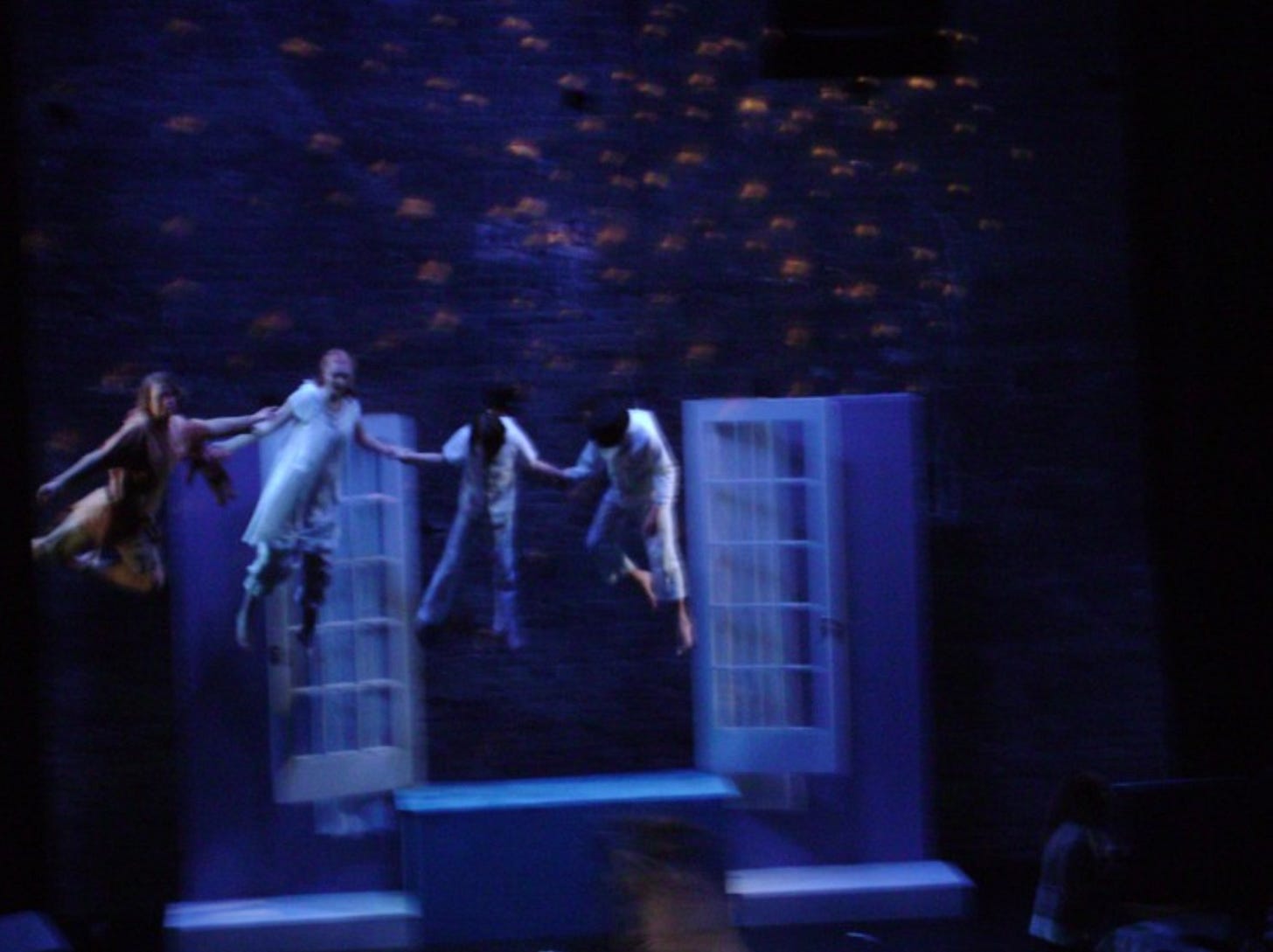That's Marvelous, Could I Do It?
A highly specific prompt designed to funnel the weight and gravity of a human heart into the container the size of a pillbox + Daniel Kahneman & the value of constraints + seeing like an artist
Yesterday I sat cross-legged on the floor in my front foyer surrounded by plastic tracks, Thomas trains, various trucks and wooden blocks. My younger sister and her grandson—who is all smiles and rolls at six months old—sat beside me. And Billie and their foster son, Z, had just disappeared to rest in the shade-filled back bedroom. A bedroom that was once, briefly, a guest room before becoming Billie’s room when they boomeranged the first time. When Billie moved out in 2021, that room became a napping-and-play room for the first round of grandbabies. Now, it is little Z’s room as he and Billie make our house their home for the rest of the summer.
The older I get, the more I appreciate the relational tides that pull and push on the space between me and my grown children as well as various other important friends and family. Well, maybe “appreciate” isn’t exactly the right word. Maybe I’m thinking of something more akin to respect, or even recognition. On my better days, it’s as if I can feel the shifts and changes—especially distance, but also the heat of closeness, as with Billie and Z right now—less as disruptive forces than as waves rising and falling beneath me, lifting, lowering, changing, preserving.
But that’s not exactly what I was thinking about as I sat on the foyer floor yesterday. What I was thinking about, as I watched my grandnephew raise and lower his tiny shoulders and scrunch his abdomen in order to press himself into my sister’s body, was the actual muscle memory of my own babies and how they moved in that exact and highly specific way against my chest all those years ago. Indeed, all three of them engaged in this exact little inch-worm routine thousands and thousands of times. As I watched my grandnephew do it, I also felt just as if he were in my arms. I was also thinking about how I can tell from the look in Z’s eye when he is about to throw a toy or doing the hard work of choosing not to throw the toy. Or how I know—by the tiniest the flicker across Billie’s face—when something I’ve said or done has hurt their feelings. In other words, I was thinking about how we integrate experience as bodily knowledge simply through repeated experience and close observation. That is, by observing our own experience in a granular way and paying very close attention, we come to see (and hear and feel and know) differently.
This week’s prompt is about practicing this type of granular observation and attention. It’s also about the value of breaking something down to its component parts—its building blocks. And it’s about tapping into the relationship between repetition, expertise, and the resulting changes in our quality of attention.
I love to consider music and musicians as an example for this phenomenon. If you are a musician, you might resonate with what I am about to say about my friend Susan, an accomplished and very talented pianist who not only teaches piano at MacPhail in Minneapolis, but also worked closely with me on music with my students when I taught elementary and middle school. Thanks to Susan’s extraordinary support, my students performed two unforgettable musicals during their middle school years: The Secret Garden with a score by Lucy Simon and Marsha Norman, and Peter Pan with a score by Leonard Bernstein. And although the grainy photos below do these plays no justice, I can tell you that these productions were life changing—not just for my students, but for me.
And one thing I discovered while working closely with Susan (and I have witnessed it again many times since) is that when a musician hears someone play music, they don’t simply appreciate how it sounds they way I do. No, a musician also notices key and tempo (including tempo changes) and myriad other aspects of technique, as well, including mistakes. Thanks to practice and knowledge, musicians hear music in a more layered and granular way than non-musicians. Their experience while listening is not only richer and more nuanced, but their intellectual understanding of what the music contains is vastly superior and more informative than mine.
It is the same with writing. As writers, we should be able to see things on the page in ways non-writers do not. For that to happen, we must practice the art of identifying and dissecting what other writers are doing. (Meanwhile, we must practice paying attention to our lives so that we can see or feel things with such precise detail that we can render these aspects of life on the page in truthful ways).
But when it comes to the task of reading like a writer, I think of this perfectly blunt quote from Phillip Larkin:
“Oh, for Christ’s sake, one doesn’t study poets! You read them, and think, ‘That’s marvelous, how is it done, could I do it?’ And that’s how you learn.”
In service of this concept, I want us to share a marvelous poem together this week: Thomas Lux's A Little Tooth. Oh, this poem. I hope you will read it. Then read it again. And again, and again.
Let it melt in your mouth. Let it fill you with its unnamable but utterly palpable force of loss and love, survival and surrender, contentment complicated enough to be real. Let the poem sit in your throat for a time, this very short, deceptively simple thing that holds the weight of a human heart inside its diminutive 65-word container.
Meanwhile, let’s discuss this poem some more so that you can, soon enough in this week’s prompt, try your hand a writing a very short thing that matters.
At first, if you were reading casually, or simply for pleasure, you could assume “A Little Tooth” was written in free verse. Indeed, I found at least one analysis online that claimed as much, which is fair, since the poem does not strictly follow any officially recognized form. In fact, I even asked my poet friends for their input on the poem’s form, but none of them could identify it as an exact representation. Instead, they saw it as having elements of several different forms, all stitched together. Some of those elements are obvious, and others emerged only after many rounds of close reading with my Writing in the Dark students.
For this week’s prompt, I distilled many components of the poem as a map of sorts to follow in your own endeavor to create a thing of great meaning in very few words. I’ve arranged the components in (what I determined as) descending order of importance, so the idea would be for you to try to incorporate at least the first several components into your own attempt to work the prompt. If that process becomes more difficult for you, if it grows harder and harder and harder and nearly impossible to adhere to the components, then let go of them as necessary in order to complete something.
Also: since the thing you will write is very short this week, you could try to write a few or several versions using the same instructions. And finally, remember that even if what you end up making from this assignment is totally unusable as "the thing it is," it can always become or inform something else. Be open!
To note, if you haven't worked much with constraints (or even if you have) and you find yourself getting super frustrated, you might find some solace in a craft essay I wrote about constraints (and what they can do!) for Cleaver a few years ago. I know some of you have read it, so here’s just a short snippet that touches on why I use constraints to help me get closer up to the words themselves, closer up to structure and form. Hint—I don’t do it in order to learn certain forms or to become a poet or to create extremely experimental work. I do it to merge myself with language in ways that differ dramatically from the tasks of talking, texting, emailing, and journaling. I do it to celebrate the wild, nearly limitless capacity of language to hold meaning not through the actual meaning of the words, but through their arrangement. I do it to discover things through writing that I would never otherwise find:
As for me, the more I experimented with constrained writing, the more I came to see its value. Still, I wondered why devices like writing constraints are so useful for accessing sharper angles on certain truths, even in cases when those truths are not particularly traumatic or difficult to tell. The answer stems from brain science, which confirms a sad fact: we’re wired to see and say (and write) the same versions of our various stories over and over, even if those versions are not essentially true—or interesting. Meanwhile, the big truths about our own lives march by unrecognized. The simple term for this is “confirmation bias,” a deep and debilitating hardwiring against seeing virtually anything we haven’t already pictured or that we don’t expect to see.
One of my favorite sources for understanding this conundrum is the book Thinking Fast and Slow by Daniel Kahneman, which explores the dichotomy between our two modes of thought: “System 1” and “System 2.” System 1 is fast, instinctive and emotional. It’s the system we use the vast majority of the time. System 2 is slower, more deliberative, and logical, the system required for solving calculus problems and working out difficult code. System 2 is taxing, and we avoid it; it raises our heart rate and makes us sweat, so we default to System 1. But there’s a hack for getting past System 1’s hold on us. All we have to do is intentionally engage System 2, which effectively disables System 1 and thereby allows us to see beyond our pre-existing beliefs.
This is exactly how writing constraints work. Constraints are like puzzles. We use System 2 to solve them, which quiets System 1, and suddenly, as if by magic, we write something newer and truer.
The prompt I’ve created for you contains a list of instructions based on things Thomas Lux did in his “A Little Tooth.” Most of these instructions could be categorized as constraining. Read through the whole list before you begin. And don’t place big expectations on this project—instead be playful, open, curious, and free even within the pressure of the constraints. Be like a kid playing with Rubik’s cube.
The idea is, make something you could never otherwise have made. If it’s junk, set it aside and try again and maybe again. But if the work my Writing in the Dark students produced this week is any indication, I suspect you’ll find something shiny here, even if it’s not a thing you can use exactly as is. Instead of expecting the prompt to produce a thing you can submit for publication the day after tomorrow, approach it instead with creative and expansive thinking around what it could become down the road: The portal to a new essay or story? The bones of a flash piece? The basis of a powerful new scene in your work in progress? A tiny message-in-a-bottle type of truth about who you have been or are becoming?











